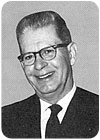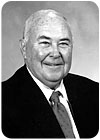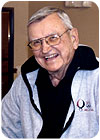

Charles
“Chuck” Clay
For coverage on our 70th anniversary, W&C sought to interview some of the industry pioneers that were both affiliated as industry leaders back decades ago, and had an existing relationship with the magazine. Several individuals were chosen and hail from different regions within the U.S. As you’ll read in this article, these individuals are responsible for bringing new products and technologies to the industry. Many were hired by government agencies to work around the country-as well as the world-on different projects. Cultural influence from regions as well as different countries was infused in the way workers stateside had been working with construction. And of course, many labored long hours to help get products approved by the codes. To this day, W&C values reporting on new products, both nationally and internationally.

Walt
Pruter
In discussing the history of this magazine, the central figure is Charles “Chuck” Clay, who first published the Northwest Plastering Industries in the Pacific Northwest in 1938. For three and a half decades, Clay wrote, edited and published this magazine (with help of course). However, even as its audience grew along the western coast, it still took until the ’80s to find its national syndication.
Chuck Clay was a journalist by profession and started the magazine up by request of area contractors in the Pacific Northwest.
“He started the magazine in the late ’30s here in the Northwest. It was always out of Seattle,” says Bob Drury, executive director with the Northwest Wall and Ceiling Bureau, and Clay’s son-in-law. Drury also helped with the magazine on a part-time basis in the early ’70s, helping with layout and other tasks.
“I’m not exactly sure when the scope of the contractors changed from plastering and the drywall aspect of the work,” Drury says. “And the name changed. The evolution of the industry went to the title and concept, and content of the magazine.”
Bob Welch became a representative and western editor for the publication during Clay’s final years as owner of the magazine. When Chuck Clay died in 1974, the business defaulted in ownership to his widow, Margaret Clay. Having full confidence in Welch, the magazine moved from its headquarters in Washington state to Southern California, where Welch and his wife Ruth began running the magazine. By this time, the magazine was now Walls & Ceilings, as the name implied the shift the industry had taken with other systems, notably drywall, acoustical ceilings and by that point, even EIFS.
“He [Bob] was working for Chuck as the west coast editor. He would go to conventions and Chuck’s wife would go and I would go too. We had some good times there. They were nice people,” says Ruth Welch, Bob’s widow.
“Chuck had cancer and when he found out about it, Bob went up to Seattle every month to put out the magazine for him. That was for about five months before Chuck died. When Chuck died, it was an awful lot to do. Margaret Clay was still involved in it. We bought the magazine from Margaret,” says Welch, who is now in her early ’90s and resides in Pacific Grove, Calif.
“He was very dedicated to the magazine,” she says. “He wanted to put out a good readable magazine and to touch base with advertisers. He was always active with the people in the industry and the advertisers.”
Bob Welch passed this February at the age of 92 from complications due to injury at his home in Pacific Grove. He was last published in W&C in 2000, with his column “The Long View.”

Bob
Drury
Walt Pruter, of Palmer Woods, Calif., has been active in the walls and ceilings trade since 1947 and to this day still holds the title as senior consultant to the Technical Services and Information Bureau, the educational branch of the Western Wall and Ceiling Contractors Association.
He began his career with United States Gypsum, where he held different positions and left when he was the national assistant sales manager of its lath and plaster products.
“When I started I was an architectural rep for them in Washington, D.C. I think I started with them about 1947. I came back from the war, went to school, got a degree and started with USG. I then went to work for Kaiser Aluminum and Chemical, located in Oakland, Calif. That’s where I thought I was going to be so they asked if I would start in Los Angeles. They got active in a program, geodesic structures. I got involved in building aluminum domes for Kaiser.”
When Kaiser wanted Pruter to go to Detroit, he declined and left the company for a position as marketing vice president for a ceramic tile company. He then started representing the Metal Lath Manufacturers’ Association and was also head of the Metal Lathing Contractors’ Association.
“I became an authority on building codes,” says Pruter. “That was my task. Even today I would say that’s my talent point. I keep current with the codes.”
Although his career has taken him down many roads, many will recognize Pruter as one of the authors of a book called the “Plaster and Drywall Manual.” Three editions have been published between 1978 and 1988. Currently, Pruter is working on the fourth edition with W&C’s Editorial Director Mark Fowler.
Pruter cannot recall when his first involvement with the magazine was but did confirm that it was writing articles for Bob Welch.
“We had lunch on a reasonably regular basis,” he says. “If he wanted an article, I could come up with those articles. He was interested in what was going on, such as the design community, as well as the contractors.”
He says he believes the biggest boom is light gauge steel framing, which he views as a good economical way of building.
One of Pruter’s dear friends and colleagues has been Dick Gorman, who has been a known W&C associate for many years. Gorman is a technical consultant for the Technical Services and Information Bureau, and does double duty for Gorman & Associates as a consultant. Gorman & Associates was founded in 2000. The Technical Services and Information Bureau is industry funded and is located in Orange, Calif. Gorman started out as technical director for the Plastering Institute. In the year 2000, that was disbanded and became the ISPE. He has been active in the industry for at least 45 years, beginning in the late ’60s.
“I have two degrees in architecture from Rice, went in the army, and one thing led to another and the options came up for the plastering industry,” says Gorman.
He observes that the biggest change in the walls and ceilings trade today is that it is far more non-union; as opposed to yesteryear, which was union.
“[But] there’s no difference between now and then. Our intent was to promote the proper use of plastering and assist plasterers to apply it properly. The function is still the same and it hasn’t varied in the last 40 to 50 years,” says Gorman.

Bob
Welch
In Northern California, a well-respected guru in Portland cement is Tom Geary. Another veteran of World War II, Geary returned to the states from injuries sustained in the war. His career in the industry was as a chemist for two suppliers of cement: Calaveras Cement and Pabco. In the ’80s, he ventured out as an independent consultant investigating job site problems.
“I began investigating problems with products. A lot of the problems were a result of contractors, general contractors, architects, and single family homes and apartment buildings. The owners of these buildings could get in on the design of these constructions and that’s not necessarily good,” says Geary, who at 91 resides in Redwood City, Calif.
As a consultant for cement, the job took him as far as Saudi Arabia to inspect a failure of building blocks on U.S. air bases being built in the country. His assignment was to identify the problem, figure out the cause, rectify it, and ultimately solve the construction issues. Culturally, he found the international experience one of the most rewarding of his career. Like Pruter and Gorman, Geary became involved with W&C as a regular contributor of technical articles.
“W&C serves as a clearing house and that’s very good and that’s needed. It’s a central point to which information can be directed and in which matters can be considered and some of the incoming information can be processed for all that read it,” Geary says.
Geary retired at 88 yet still is happy to converse with industry friends and help out anyone with questions.
Clint Fladland, former executive director with the Minnesota Lath and Plaster Bureau, recalls the excitement of meeting his counterparts of other associations and bureaus throughout his time in the industry. A veteran of World War II, Fladland started working in the industry for Zonolite, a supplier of plaster aggregates, fireproofing, steel, metal lath and insulation products. He did this several years before joining the MNLPB in 1958.
“I was selling to architects and they thought that it would work out good to have me on staff to promote the business to architects and specifiers. At that time we were still trying to promote plaster vs. drywall. It wasn’t until the ’70s when Dryvit and EIFS changed our approach. But at that time we were trying to sell plaster and lath products. And metal framing was big back in the ’70s,” recalls Fladland when asked what were the products he recalls being introduced. “We had both interior and exterior metal framing. We did a lot with exterior wall systems at that time. We were promoting stucco systems on all kinds of exterior products. I was deeply involved with the industry. We travelled around the world.”
Fladland visited Europe, Scandinavia, Japan and Australia.
“Those were very interesting trips because we became more global in our thinking. So the walls and ceilings industry was cultured through these trips,” he says.
In his opinion, Germany by far had the most influence, because he says that’s where the “cementitious stuff” came from. “We got Dryvit in Minnesota in 1971,” he says. “It was very hard to get that speced in Minnesota. We had different tests going for fireproofing and wind resistance and you had to prove the product through the ASTM methods. We got involved in code things in those days.”

Clint
Fladland
A true gentleman and scholar is Archie Eugene “Gene” Erwin, who began as a scaffold erector in Ohio after he got out of World War II.
“My parents convinced me to take advantage of the GI Bill, so I went to a college in Ohio, and while I was working through that, I served in an apprenticeship as a plasterer. I was working for several contractors in that industry around Akron, Ohio. When I finally graduated from Kent State University, having gotten married, I was making $2.50 an hour as a plasterer. That’s how I got in the construction industry and involved in lath and plaster,” says Erwin.
Including his apprenticeship, he spent 17 years working for a multi-generational family of plasterers from England that specialized in conventional and ornamental plaster. After this, he went to work for a state contractor’s association and then was asked to go to a convention of what was called the Contracting Plastering and Lathers International, an international trade association.
“I was the technical secretary of that organization. I got interested in the chemistry of making these materials. I began to participate in representing the industry. And finally, the drywall and plasterers came together,” Erwin says. This stationed him in Washington, D.C. for 10 years, before he left to head up a new association called the Southeast Bureau for Lathing and Plastering, representing the Southern states in 1978, positioning himself in Atlanta.
Needless to say, Erwin has lived across the whole Atlantic coast, serving under various titles.
Basically, Erwin says he was interested in the technical aspects of the industry, writing standards and getting the quality up. As a consequence of being involved in the industry, Erwin began to participate on their behalf on a number of technical committees such as ANSI and ASTM.
Finally, in 2001, Erwin stepped back from his position as an independent consultant and relaxed in Clayton, Ga. He lives there with his wife and is active in activities, both formal and informal, with World War II vets.
Interesting trivia note: Where Erwin resides, in Clayton, was the film base for the Warner Bros. production of John Boorman’s Deliverance (1972). Both stories, those of W&C’s long-standing friends and those of the Atlanta suburbanites based on the poet James Dickey’s novel, explore how we end up in places we never expect. Just ask the interview subjects in this story. W&C
By Walls & Ceilings staff
Write Ruth
Bob Welch’s widow Ruth has asked Walls & Ceilings readers and friends of the industry to write her. She appreciates hand-written notes and has provided her address:
Ruth Welch
507 Evergreen Rd
Pacific Grove, CA 93950-3866

Report Abusive Comment